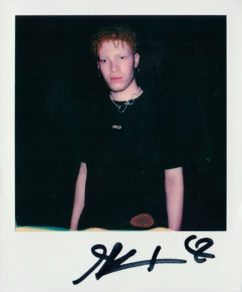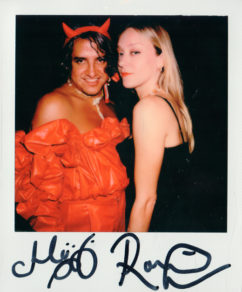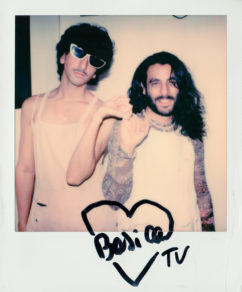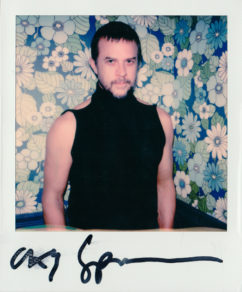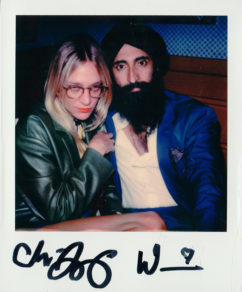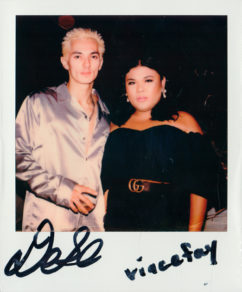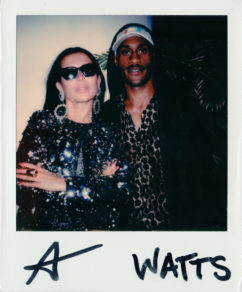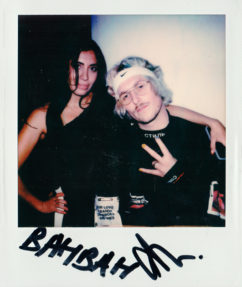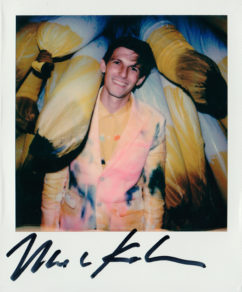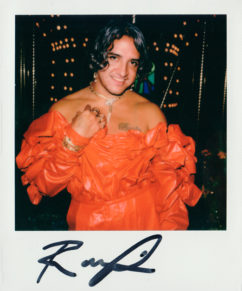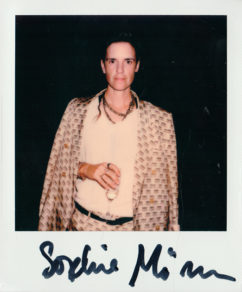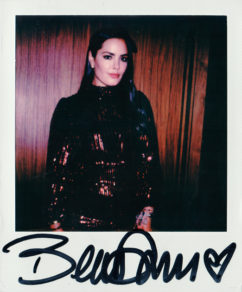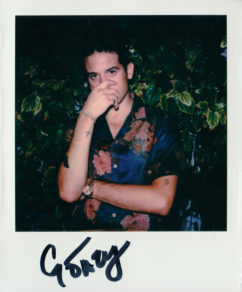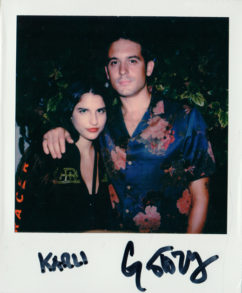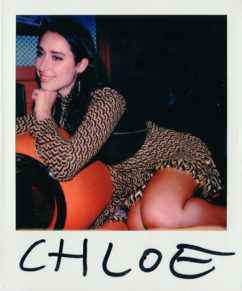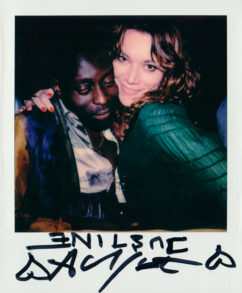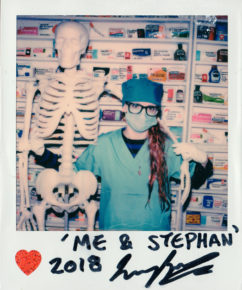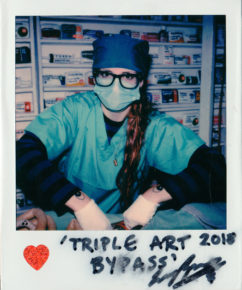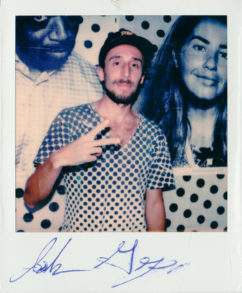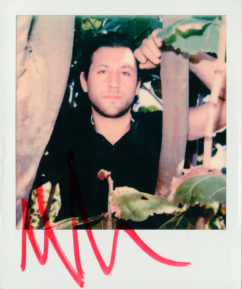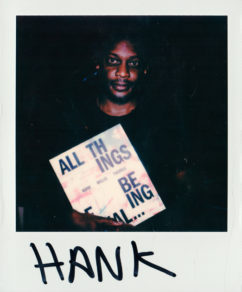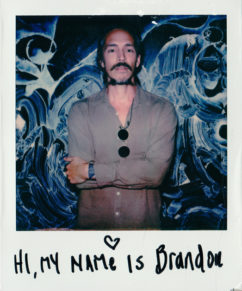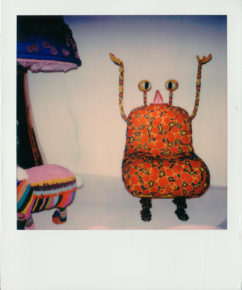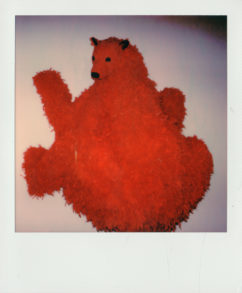Friday 07.12.19
Robert W. Richards’ Dreamboys
The renowned illustrator on redefining sex and fashion, the Manhattan dreamscape and the end of bitchy.
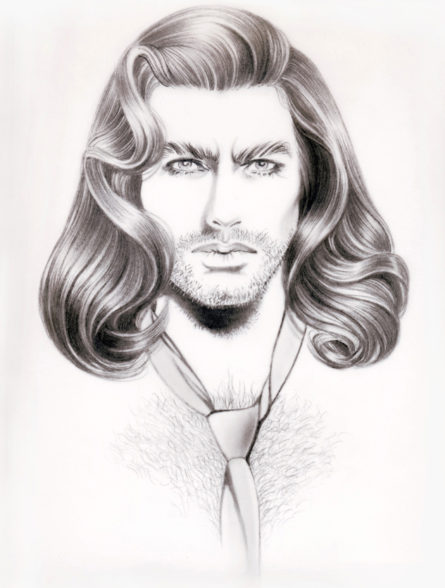
Robert W. Richards began his career as a fashion illustrator, traveling the globe and sketching runway shows, both enamored by and afraid of the clothes he drew. But it was when he returned home to New York for good that he began focusing not on couture clothing but on what lay beneath. Long, lean, sculpted male bodies became the chief characters of Robert’s drawings — all isolated images devoid of background and unnecessary detail. “A good drawing should speak for itself,” Robert told us. His drawings do.
Plenty of nods to fashion or labels are illustrated with whimsy and lightheartedness, yet the boys Robert depicts are often strong and severe. His most recent work — a series of nude boys with designer shopping bags — encapsulates his perfect intersection of fashion and sexuality. Here they are: simple line drawings, sexy yet soft. We spoke to Robert about his arrival to New York, his imagined-turned-real lover, and how he escaped the fashion world to illustrate a world of his own.
How did you land in New York City? I left home, in Maine, when I was very young. Just a little bit shy of 16 in the late ’50s. I went to school in Boston, but always I was conscious I wanted to live in New York. Boston was just a stop along the way for me.
Was it difficult leaving your family and small-town life? My mother didn’t want us to dream, because she had had a lot of disappointments in her life. …

Tuesday 07.09.19
18: A Series of Booklets by Gerardo Vizmanos
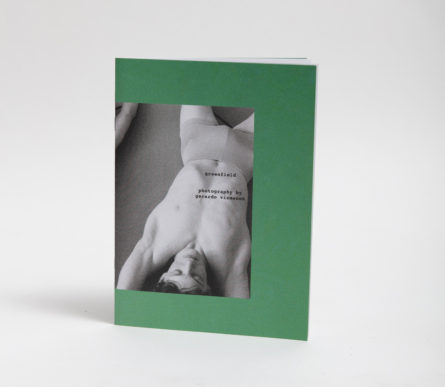
Gerardo Vizmanos believes 18 is a magic number. He’s launched a series of photography booklets entitled “18,” each $18 and 18 pages long. Vizmanos’ photos are all about the male figure. Young models (mostly dancers) are posed beautifully, arms stretched, bodies bent and twisted so muscles and bones can be seen. At 18, children become adults; Gerardo suggests this is what makes the number magical. That idea comes through in his photography, “When I work with some young models, I see an idealization of the memory of my own youth, not what I was, but probably what I’d have wanted to be then.”
Gerardo’s models hold themselves in what must be awkward and uncomfortable positions, yet the poses always end up looking natural. In one photo, a model rests his shoulders on the ground, but bends backwards so his feet are behind his head. In another, one model bends his knees, positioning himself like a chair, while the other model sits on his legs. Vizmanos is meticulous about getting each pose right. “I guess I direct a lot. Maybe too much, but this is my way of working. This is for me the key aspect of every shoot. To engage with the model to get that natural pose. It’s the part I love the most.” As to how he finds models willing to bend over backwards for him, Instagram and Facebook are his main sources. They allow him to find models from all parts of the world.
Vizmanos posts a lot of his photography on social media, but has decided that paper is the best format for his work. …

Friday 06.14.19
Pride: Photographs After Stonewall by Fred W. McDarrah
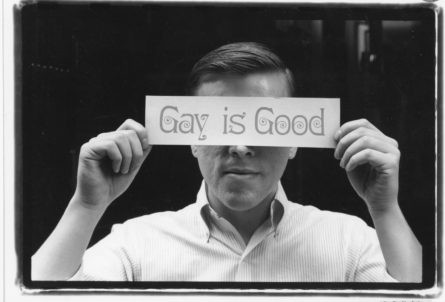
Fred W. McDarrah was the first on-staff photographer for the Village Voice. His prolific photography captured both the pride and the struggles of the gay community toward the end of the 20th century. In 1994 McDarrah published a book of photographs focused on the changing queer community in Greenwich Village from the events of Stonewall up to the mid-1990s. 25 years later, a new, redesigned edition of McDarrah’s book has been released by OR Books — Pride: Photographs After Stonewall with a foreword by Hilton Als. It is no coincidence that the book was released this year, exactly 50 years after the Stonewall Riots. The book’s cover features several rioters and Stonewall patrons posing for a photograph during the riots. Above them, a message etched in chalk reads, “To fight for our country, they invaded our rights.”
Pride is split into two parts: photographs before Stonewall and photographs after Stonewall. The before section paints a vibrant picture of queer 1960s New York. Gay poets and writers like Frank O’Hara, W.H. Auden, and James Baldwin pose for portraits, a powerful photograph of the American transsexual icon Candy Darling, drag queens and transgender women competing in the Miss All-American Camp Beauty Pageant of 1967 are photographed wearing identical outfits and sashes that display their title. Actor-turned-activist, Jim Fouratt summarizes the decade: “I came to New York in the early ‘60s to be a bohemian/beatnik artist. I found the Actors Studio, Lee Strasberg, Greenwich Village, jazz, mary jane, gay bars, drag queens, Andy Warhol, the Judson Church performers, the Living Theater, the Caffe Cino and La Mama, civil rights marches and sit-ins, the Open Theater, Communist, poetry, dirty old men, Lenny Bruce, rich people, and my first real boyfriend. …

Wednesday 05.29.19
Send Nudes: Jonathan Icher’s Perfectly Proportioned Organs
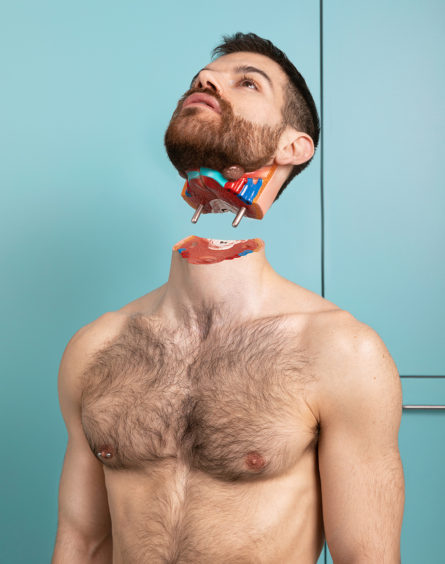
Is beauty only skin deep? In considering how our world of social media and dating apps pushes us to have a certain idea of beauty and desire, Paris-based photographer Jonathan Icher attempts to answer this question. His new series, Send Nudes depicts models with their organs on display. “Models with perfect figures pose naked and offer a new degree of intimacy. Their smooth and perfected organs are offered on display without reserve. Sometimes in excessive proportions, they try to provoke our envy.” Icher is responding to how easy it is to present yourself as perfect on social media with filters and editing. In planning this project, Jonathan posed the question, What’s the next step? How can we make our bodies even more perfect and attractive? “I imagined that the inside of the body, guts and organs, could be the new way to show our fake perfection in a new media. Organs are presented in this series, perfect, really clean and bright on the bodies.”
There’s a sexual element to Icher’s perfectly proportioned organs. In some photographs, organs like the heart, intestines, and lungs are excessively large and sit outside of the body. Like muscles, butts, and bulges, their large scale attracts sexual attention from the viewer. This was Jonathan’s first time using organs in his work, but he’s incorporated the human body and body modifications in previous projects. Jonathan loves to mix sexiness with weirdness. “Most of the time we are attracted to certain kinds of bodies (depending on what the fashion or porn industry is showing us) and I like to confront these kinds of bodies with something strange, or….not …

Friday 05.17.19
10 Polaroids from Tom Bianchi’s time in New York City
Featured in his latest book, 63 E 9th Street: NYC Polaroids 1975–1983
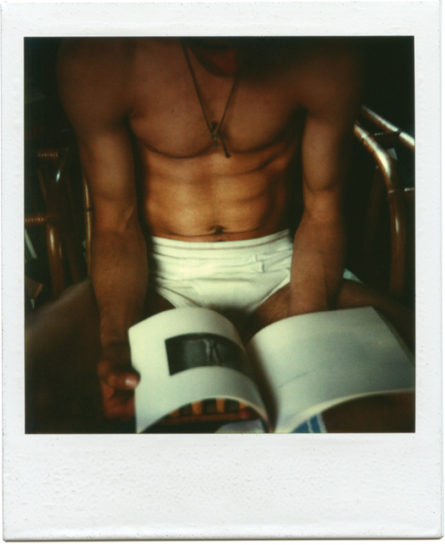
I was about 25 when I discovered that a walk down Christopher Street in Manhattan was as cruisy as a walk down the beach in the Pines. In the early 1970s, as my generation was coming out loud and proud, the cityscape provided a fresh venue for our frequently manic celebration.
Most of us came from a sexually repressed, homophobic place — a place America was and, too often, still is. But New York’s streets, bars and clubs provided a safe space for us to connect with like-minded libido-driven souls. Day or night, my Ninth Street apartment existed as a stage designed for play. We created ourselves as one another’s fantasies.
Anxious as we were to get into each other’s pants, we remained ever vigilant for the guy we hoped might return our gaze. And these were paradoxical years. We were militant young men outside, fragile boys inside. But from time to time — for a while, at least — we found love in each other’s arms. That’s why I always kept fresh flowers about.
Click here to get the book 63 E 9th Street: NYC Polaroids 1975–1983.
…

Tuesday 05.14.19
Art After Stonewall
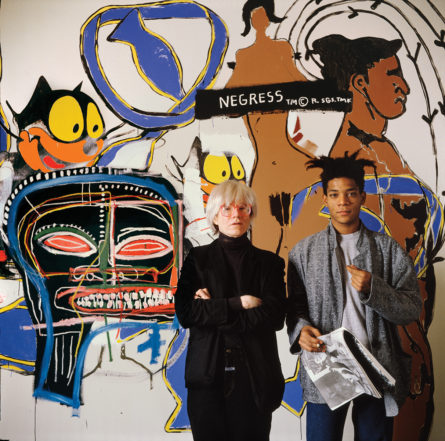
50 years ago this June, the Stonewall Inn was raided by the New York Police Department, triggering one of the largest confrontations in LGBTQ history. Since that night, many battles, like marriage equality and the HIV/AIDs crisis have been fought. We’ve had big wins and realized some worrying losses. Reflecting on Stonewall allows us, of course, to celebrate our victories, but also inspires us to press on and keep fighting for those in our community that still face intense social and political marginalization. Jonathan Weinberg has published Art After Stonewall, 1969-1989, a book focused on the legacy of Stonewall that highlights more than 200 artworks “spanning the two decades between Stonewall and the AIDS crisis.” Among the many featured artists are Alvin Baltrop, Cathy Cade, Gran Fury, Nan Goldin, Harmony Hammond, Lyle Ashton Harris, Tseng Kwong Chi, Peter Hujar, Greer Lankton, Mcdermott & Mcgough, Robert Mapplethorpe, Catherine Opie, Adam Rolston, Shelley Seccombe, Andy Warhol, Jean-Michel Basquiat and many more.
The book is pretty badass. Chapter Two (Sexual Outlaws) opens with Catherine Opie’s photograph, Raven (Gun); a woman sits bare-chested on a couch, her nipple piercings connected by a silver chain. Arms stretched out, she aims a gun into the distance. On the adjacent page a quote by Flavia Rando reads, “We knew there were lesbian bars in Greenwich Village, but the mob bouncers could prevent women from entering. You could be judged too black, too brown, too young, too poor, or the police might raid and you could be arrested for wearing the wrong garments.” …

Thursday 04.25.19
LOUIS FRATINO: “COME SOFTLY TO ME”
New paintings celebrate gay sex and reimagine birth.
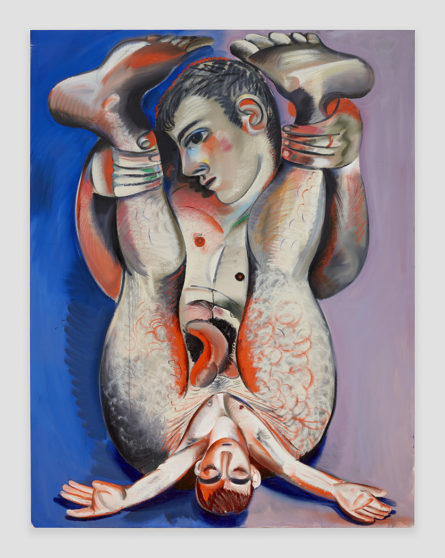
Louis Fratino has an informal, homoerotic Instagram account @boy.drawings where he posts figure studies. His fans, both critics and pedestrians alike can see his technical drafting and beautifully rendered cocks. It’s the best of both worlds. Writing for the New York Times in 2017, legend Roberta Smith said Fratino’s work is “hot with painterly attention and erudition.” On my stop in to “Come Softly To Me,” his first solo show with Sikkema Jenkins & Co., I overheard a gay man (serving as cultural attaché) telling his friends from out of town, “It’s a gay show. That’s why I like it!”
“Come Softly To Me” offers 25 new paintings that vary in scale and oscillate between modernist figure paintings and progressive celebrations of the male form. Progressive because the men in the paintings are clearly gay. Fratino’s subjects are comfortable in their own skin, unafraid of being seen. When coupled, they entice his viewer into a languid world free of judgement, and he uses intimacy, lovers, family, and friends to “present the human figure as a site of vast emotive expression.” He has said that his paintings are an attempt to make himself vulnerable and able to speak about his own life honestly. Pairing the modernist approach to personalized subject matter directly links Fratino to the show-stopping stylists of today like Dana Schutz and Nicole Eisenman. Respectively, the two painters have helped re-situate American painting by forging new paths that Fratino now grazes on.
Out of the several large scale paintings on exhibit, “I keep treasure in my ass” and “Kissing Couple” are likely to get the most air time. …

Friday 03.29.19
James Bidgood: Reveries

James Bidgood moved to Manhattan in the 1950s and began taking his colorful, dream-like photos of men in his cramped Hell’s Kitchen apartment. The Museum of Sex’s new exhibition, James Bidgood: Reveries curated by Lissa Rivera, explores the artist’s unbelievable photographs. There was nothing quite like his work at the time; ornate nudes and semi-nudes taken with props and backdrops to give the illusion of a photograph taken underwater, in Paris, or in some other dream landscape. The creativity in Bidgood’s work is stunning. In my favorite photograph of his, Lobster, a model wears a sparkling seashell thong and holds two lobsters in his hands. The camera points up toward his crotch and face; the model’s body and hair are glimmering, and you can see stars in the night sky above him. The photograph is from Bidgood’s photography series, Water Colors, which was his first attempt at erotic photography.
Also on view from Water Colors, is Trunk, which depicts a man effortlessly floating in the ocean near a treasure chest. Bidgood went through an elaborate process to create this scene, covering model Jay Garvin’s body with “mineral oil, glitter, sequins, and small seashells. To create the illusion of weightlessness, Bidgood balanced Garvin on a foam-padded-café-table pedestal, hidden behind his leg through forced perspective.” Bidgood was formally trained at Parsons School of Design, and spent years designing gowns for wealthy New Yorkers, most notably for the annual Mardis Gras Ball of the Junior League. Little did the society girls know, after designing their gowns Bidgood would take the dresses apart and use them as costumes and set design pieces for his photographs. …

Tuesday 03.12.19
Fire: A Little Piece of Fire Island

I’ve never been to Fire Island, but I’ve heard about it. Stories about a gay paradise: parties, sex, drugs, the Meatrack… A place for fun and friends where you can be yourself and not worry about what anyone else has to say about it. Ryan McNamara has curated the work of 17 queer artists into an exhibition simply entitled Fire. It captures the experience of Fire Island. Littered on the floor are fliers for DWORLD Underwear Parties that read “The pool is open at 2:00AM for a skinny dip!” and “NYC’s hottest Go-Go.” In the center of the space is a sculpture of a squatting boy called “Boy’s Tears” by Cajsa von Zeipel. It’s surrounded by sand, towels, flip-flops, and deflated beach balls. An empty bag hangs on the wall. Scribbled on the front of it in marker is the description, “K8’s Jockstrap Collection Bag. Do it for fashion!” Next to the bag, K8 Hardy fitted several jockstraps onto a fiberglass mannequin. A wood and plaster creation (“Chemical Compound”) by Ryan McNamara depicts countless faceless figures kissing, sucking, and fucking in the biggest orgy I’ve ever seen.
Walking through the exhibition is exciting, it’s like walking through the remnants of a wild beach party that just ended an hour ago. I felt like dropping everything and going to Fire Island to experience the inside-jokes, and the community that seemed to be all about acceptance and having a good time. In organizing Fire, Ryan McNamara makes a statement about the importance of queer spaces. …

Wednesday 01.23.19
Andy Warhol: By Hand, Drawings from 1950s-1980s
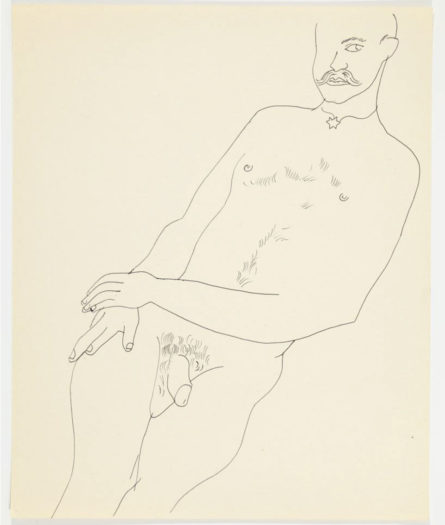
In 1982, Andy Warhol, and several other artists, established the New York Academy of Art, a school focused on traditional education in drawing, painting, and sculpture. Warhol provided funding as well as creative input, and now, more than three decades after his death the academy has put together a new exhibit. Andy Warhol: By Hand, Drawings from 1950s-1980s features drawings and sketches from throughout Andy’s life. Over 150 drawings will be on view — many of them never before exhibited in the United States.
Among many artworks, there are male nudes, which were drawn in the 1950s and never meant for publication or exhibition. It was illegal to distribute that kind of content back then, so the sketches were used just for Warhol’s studies — men laying naked on their backs, depictions of penises, butts. Also on view are sketches for a “Boy Book,” a study of the male face and figure, which was never completed. Andy drew his male friends, but gave them long eyelashes and added little hearts to some of the portraits. There’s a subtle femininity to these men that helps them appear boyish. Separate from those sketches are a collection of male portraits. Men with their bodies relaxed, their legs spread, often shirtless.
A founder of the Andy Warhol foundation, co-curator of this exhibition, and longtime friend of Warhol, Vincent Fremont explains, “It is important for people to know the vital role drawing played in Andy Warhol’s life as an artist. By focusing only on Andy’s drawings, this exhibition is a way to highlight without distraction Andy’s innovative process and experimentation which encompassed pen and ink, ballpoint pen, blotted line, graphite, and acrylic paint.” …

Friday 12.21.18
Polaroids from Miami Beach Art Basel 2018
With Michèle Lamy, Chloe Sevigny, Raul de Nieves, Miles Greenberg, Misha Kahn, Scooter Laforge, BasicaTV, Brandon Boyd, De Se, Matthew Morrocco, Casey Spooner and many more...
Wednesday 12.19.18
SLAVA MOGUTIN: XXX FILES
The latest exhibition of special edition prints exclusively at Tom of Finland Store
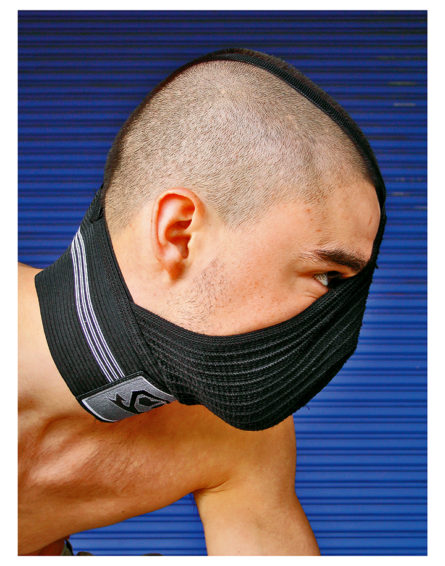
The Tom of Finland Store is equal parts online boutique and gay art gallery. We’ve seen exhibitions of work by Bruce LaBruce, Jack Pierson, Daniel Trese and now their latest — a collection of special edition prints by the artist Slava Mogutin (titled Slava Mogutin: XXX Files) exclusively available on their site. The online exhibition launched in December 18th, a day after Tumblr decided to ban adult content. It’s one of the dumbest thing we’ve heard about this year, wasn’t pornography the only reason why people went on Tumblr in the first place? Our GAYLETTER XXX Tumblr got closed down after a few successful years and a massive following, but you know what, who cares, it’s time we all leave Tumblr and show them that we don’t need to support their regressive, homophobic ideals.
“For me, the personal is political and the political is personal. At the time when our fundamental constitutional rights are under attack, I believe that queer imagery can serve as the most effective weapon against hypocrisy, bigotry, and censorship. When they censor my work either on social media or in real life, my response is always — double up on the queer, double up on the fight and what they don’t want to see. I want to shine light on the darkest corners of human nature and sexuality as a way to understand and peacefully coexist with each other, because being different is a blessing, not a curse.” — Slava Mogutin.
This exhibition is composed of photographs, performance and film work from different stages in Slava’s career. …






